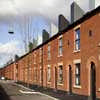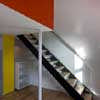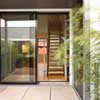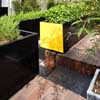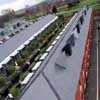Chimney Pot Park Manchester, Langworthy Homes, Salford Housing Design
Chimney Pot Park – Salford : Langworthy Housing
Housing Development northwest England design by shedkm, architects
21 Apr 2008
Chimney Pot Park Salford
Location: Chimney Pot Park, Langworthy, Salford, north west England
Project Description
chimney pot park demonstrates an innovative response to the regeneration of an area of existing terraced housing previously earmarked for demolition. this collection of reconfigured victorian properties rethink the terraced house to address the needs of modern living and turn an area of dereliction back into a community. the larger, open plan living spaces are lifted to first floor level and into the previously unusued roof space, and extend externally to individual garden areas over covered parking below. at ground floor, bedroom and bathroom are accommodated in the more cellular spaces.
The first phase of the development contains 64 houses, occupied since the summer of 2007, with the remaining phases – a further 285 homes – due for completion later this year.
At chimney pot park, an established architect and developer team, in partnership with salford city council, english partnerships and nwda, have tackled a regeneration project that, on completion, will substantially rebuild and reconfigure 349 two-up two-down terraced houses.
The area of seedly and langworthy had previously suffered from long-term underinvestment and neglect, leading to a low demand for property, low property values and widespread areas of dereliction. The developer had been approached by a local mp for ideas to redevelop the site reusing the existing houses.
The architect’s response turns the traditional layout of the terraced house on its head. The brick street frontages have been kept, retained by a steel frame, the houses and back alley spaces behind have been rebuilt to modern standards and have been totally reconfigured.
The existing street and housing patterns have largely been maintained, retaining a high density of occupancy in a low-rise scheme. The brick elevations have been cleaned and repointed. Free from patchwork paint and the odd bit of stone cladding, the brick returns a warm uniformity to the site. Front doors and windows have been replaced – their modern simplicity a suggestion that behind the brick, things have changed.
The rebuild has allowed each house to be totally remodelled internally, albeit to the proportions dictated by the original houses. The space previously within the roof has been opened into a single volume with the first floor. With a mezzanine in the roof space this provides a relatively large, well proportioned space. This is the crux of the design: this larger open plan space, open to the pitch of the roof, is given over to the living space; the largest space given to where the most time is spent. The smaller spaces – two bedrooms and a pre-fabricated bespoke bathroom pod – are on the more easily-divided ground floor.
There are two main unit types, sharing the same ground floor arrangement: one has kitchen/dining on the first floor and has a snug mezzanine living space; the other has the living dining space on the first floor and a mezzanine kitchen. Each mezzanine gains natural light from an element distinctive from the street – the ‘chimney’ rooflights are a modern interpretation of the chimney stacks and distinctively signal the new houses from the street.
The third aspect of the scheme is in its reuse of the spaces between the backs of the houses – formerly occupied by irregularly added outriggers, back yards and back alleys. Problems in this area associated with security, maintenance, ownership and clarity of form are addressed by their replacement with a courtyard garden. So as to relate to the first floor living, the garden is raised to the first floor, in turn forming a covered secure parking area below.
This outdoor space has a communal feel but with each house having its own clearly defined private area. Though predominantly hard-landscaped this space is considerably softened as all dividing and screening elements are planted. Each individual space is defined by a steel frame balcony box, opening directly off the living area. Private areas of timber decking are screened from their neighbours by planted bamboo screens and from a communal walkway by a large planter. Each planter contains a different single species of herb, together forming a linear herb garden.
Site works commenced in autumn 2005, with the first phase of 64 houses being completed and occupied in summer 2006. A further phase is now complete, with the total of 349 properties due for completion in autumn 2008. The team has worked to an overall budget of £24m, equating to a first phase budget of £4.8m. The developer originally committed to building the first phase of the scheme – overwhelming market interest led to a commitment to the whole scheme shortly after work commenced on site.
manser medal
The regeneration of three hundred and forty nine ‘machines for living’ in Langworthy demonstrates the power of Modernism to inject vitality into existing urban grain. Behind the facades of these rows of Victorian terraced properties sit re-thought homes with light interiors of pure colour, lofty spaces and long views. The contrast with their ragged and boarded-up predecessors could not be clearer.
The typical cross-section of Chimney Pot Park’s terraces is the key to seeing beyond their aesthetic improvements. Previously, living would take place at ground floor – the living room, kitchen, and back alley – this is all now elevated to first floor level. The back alley becomes an elevated garden sheltering a secure car park, at a stroke providing access to light, security and privacy. A continuity between this deck and the living spaces provides long views, as does the disposition of spaces on the ground floor.
These proposals are not suggested as the solution for regenerating all terraced housing. Placing the living accommodation at the upper level is clearly not appropriate to all user types, and given the existing building constraints the incorporation of modern space standards is clearly not possible. However, Chimney Pot Park represents a valuable solution which offers diversity of housing types within areas of terrace housing, hopefully encouraging younger people who might have previously dismissed the ‘terrace house’ to enjoy living in these areas and reinforcing the existing communities.
The scheme for Langworthy has been conceived with affordability in mind, with subsidies allowing initial retail prices to be extremely close to construction costs, with over a quarter being offered for sale through the government’s ‘first time buyer’ scheme, further broadening its inclusivity. The new homes might be most appealing to young professionals working in Manchester, in itself bringing a diversity to Langworthy, but also provide places to which Salfordians can move without leaving the area entirely.
Retention of existing urban grain has allowed the scheme to plug into a local infrastructure seamlessly, a continuation of the ‘straight off street’ character. The local shops are bolstered by the arrival of the new residents, and the scale of developments has remained respectfully inconspicuous.
Security through overlooking and perceived ownership of pavements has been retained too, something which could have been lost in a higher density scheme. The replacement of back alleys with a raised garden has hugely increased the security too. Pedestrian permeability is maintained through all the streets in the sceme, integrating it within its local surroundings as opposed to turning its back on it and creating a gated community.
Being sited within walking distance of a Metrolink station is a natural advantage, giving access to Manchester city centre and a national rail network. For car users, convenience has been integrated in the form of secure covered car parks, concealed to the rear of the property. This inclusion of the car has not been allowed to have a negative impact on the safety of streets, as all lateral streets are managed such as to allow only resident traffic giving places to play at front and rear.
Living up at first floor level is a spacious and light experience, in contrast with the gloomy ground-floor conditions of the former properties. By concentrating the cellular spaces downstairs, the upstairs can be open-plan, with long views through the large glazing to the decking and shared garden. A modest mezzanine in place of the loft means that the perceived ceiling height is much greater. The downstairs is by no means neglected, incorporating a slick bathroom-pod solution, and an innovative light well to ensure that the rear bedroom remains airy and adequately ventilated.
Chimney Pot Park Salford – images / information from shedkm Apr 2008
Chimney Pot Park architects – shedkm
Location: Langworthy, Salford, Manchester, Northwest England, UK
Manchester Architecture
Contemporary Manchester Buildings
Manchester Architectural Designs – chronological list
Manchester Architecture Walking Tours
New Islington competition : Tutti Frutti
Chimney Pot Park : Salford building
Buildings / photos for the Chimney Pot Park – Salford Homes page welcome
Website: Manchester

